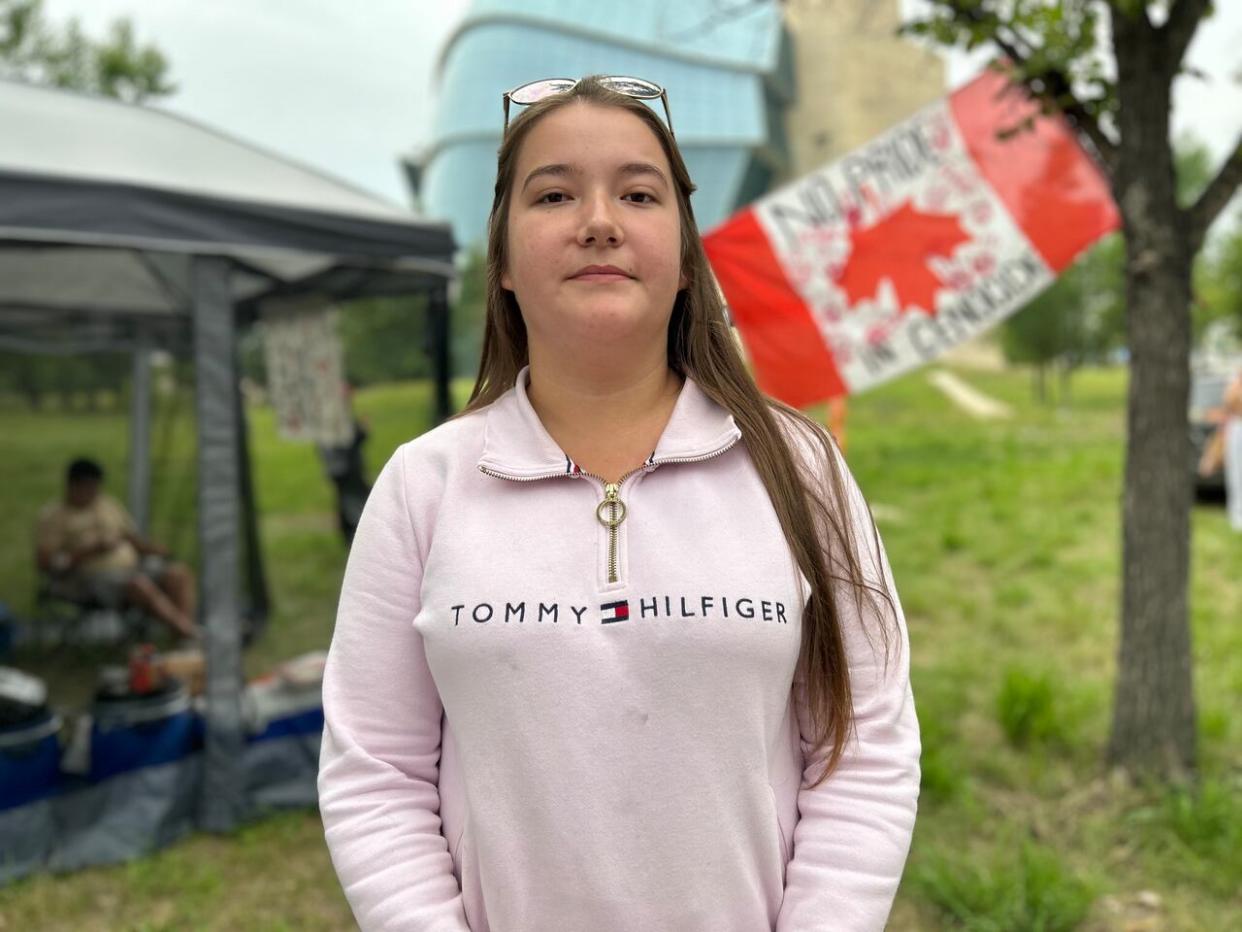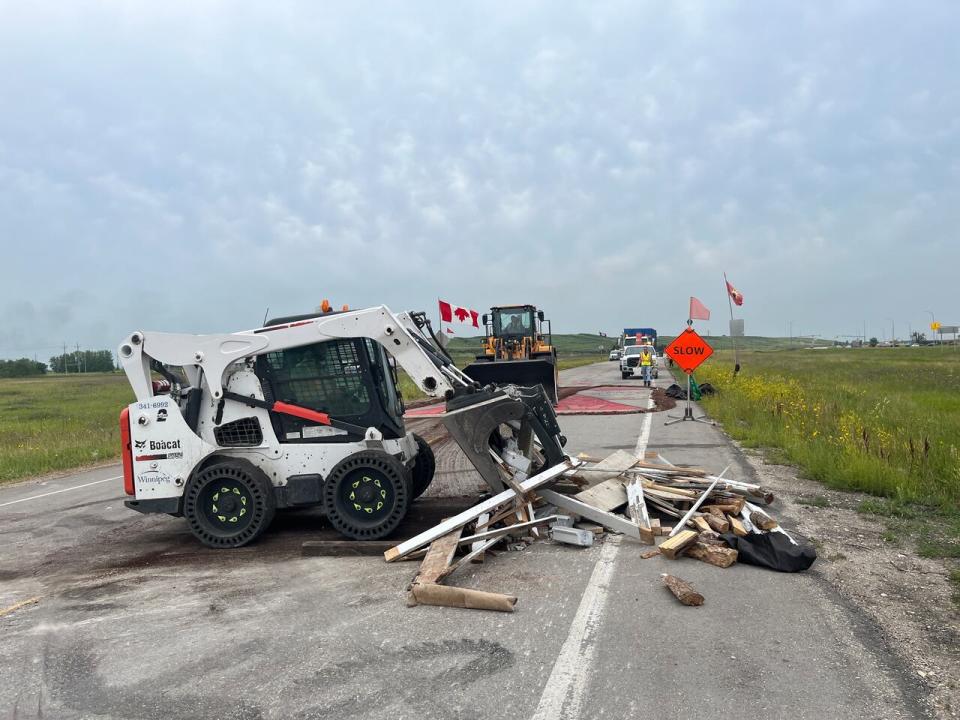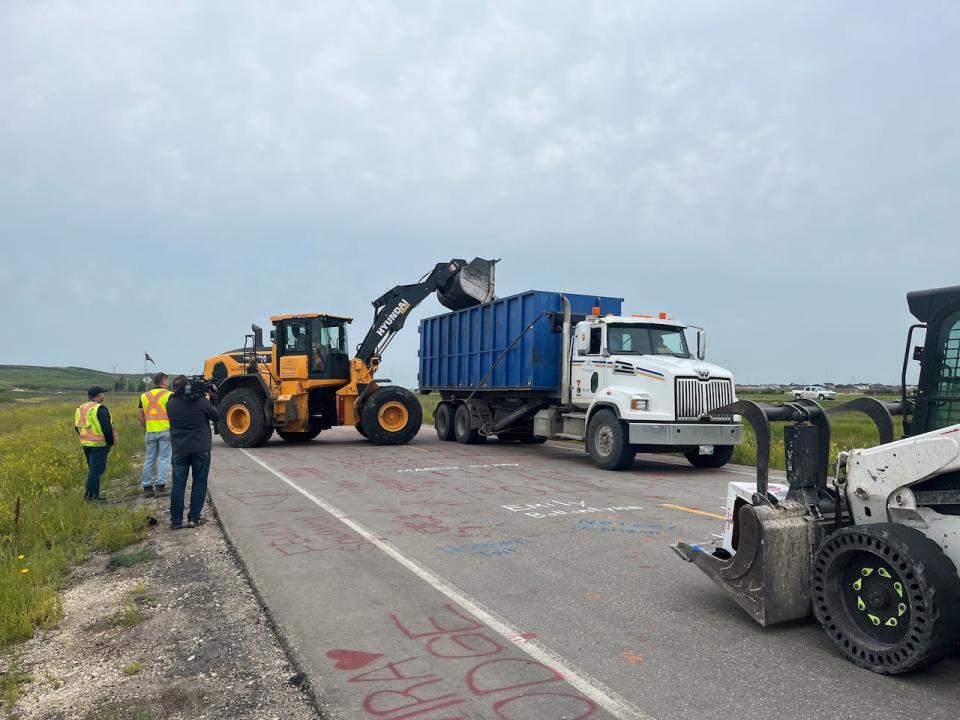Protesters set up new camp at human rights museum after city crews clear blockade at Brady Road landfill

Protesters who had been blockading the entrance to the Brady Road landfill have set up a new camp beside the Canadian Museum for Human Rights.
The new camp, named Camp Marcedes, pays tribute to Marcedes Myran, one of two women whose remains police believe are in a privately owned landfill north of Winnipeg.
"We wanted to open another camp to obviously keep her spirit alive and her name. and we plan to keep camp set up and to protest until the search of the landfill is done," said Jorden Myran, sister of Marcedes.
She hopes having a presence beside the museum, near The Forks and the Esplanade Riel, will make the camp, and their message, more visible.
"This is a place where there's lots of people coming by, right? It's in a place where there's lots of public, and it's not as far as the Brady landfill. So we're hoping to get a lot more eyes and a lot more, you know, voices out here."

A skid steer breaks down part of the blockade at the Brady Road landfill on Tuesday. (Anne-Louise Michel/Radio-Canada)
City of Winnipeg crews, with police present, took down the blockade at the entrance to the Winnipeg landfill, four days after a judge granted an injunction ordering protesters to clear the road.
Heavy machinery scooped up pieces of wood and tires that formed the barricade and deposited it into a truck on Tuesday morning, while police spoke to protesters at the site.
"The people that were here for the blockade were very co-operative," Insp. Gord Spado said at a news conference Tuesday morning.
"It was kept peaceful. The protesters removed things they wanted to keep off the roadway, and that allowed the city to come in and assist us in removing the material that was still blocking the road."
The blockade was built on July 6 after Manitoba Premier Heather Stefanson said her government won't pay for a search of the Prairie Green landfill, north of Winnipeg, where police believe the remains of two First Nations women — Morgan Harris and Marcedes Myran — were taken last year.
A Manitoba judge granted the City of Winnipeg the injunction on Friday afternoon, but the protesters continued to occupy the road.

Heavy equipment removes the barricade outside the Brady Road landfill on Tuesday. (Anne-Louise Michel/SRC)
Spado said police wanted to give the protesters a few days after the injunction was served before tearing down the blockade.
"Any time we can resolve things in a peaceful manner and not have to go in with any show of force, we definitely prefer that method. I was very happy with today's outcome," he said.
No arrests were made, he said.
The road to the landfill was expected to be entirely clear by noon, Spado said.
Winnipeg Mayor Scott Gillingham says he's relieved the road was cleared.
"It was always the goal to find a path to resolve the blockade through dialogue and so I'm grateful to everyone involved there on the ground that made it possible to end the blockade peacefully," he said in a phone interview on Tuesday.
Joseph Munro, one of the leaders of the protest, told CBC News after the police news conference that this isn't the outcome people hoped for.
"A lot of people are disheartened the road's being reopened," he said.
Derek Nepinak, the chief of Minegoziibe Anishinabe, also known as Pine Creek First Nation, travelled to Winnipeg to visit the protest Tuesday morning and "bring honour to the warriors of the camp," Munro said.
He gave Munro an eagle feather, saying it has been at protests across the country, Munro said.
"It represents love. That's how our nation is supposed to fight. We're supposed to act out of love," Munro said.

Joseph Munro, one of the leaders of the protest outside the Brady Road landfill, holds an eagle feather he was given by Chief Derek Nepinak, who travelled to Winnipeg to support the demonstrators on Tuesday, Munro said. (Josh Crabb/CBC)
Protester Harrison Powder, who spoke to media after the police news conference, said the fight to have the Prairie Green and other landfills searched isn't over.
"You can bet that other activists, other warriors, will take action," Powder said. "There will be another blockade. We'll blockade railways, we'll blockade highways."
Justice Minister Kelvin Goertzen repeated the premier's message about safety concerns.
"Nobody is suggesting that this is an easy decision, nobody is suggesting that there is a perfect decision in this, but there is a responsibility of government to think about the safety of others as well, which doesn't take away from the challenge or the hardship that families are feeling," Goertzen said Tuesday.
Research done by the committee that studied whether a search of Prairie Green would be feasible already addressed those concerns, and said the search can be done safely, committee members said at a news conference on Monday.
Goertzen cited unnamed experts who dispute the committee members' comments.
"There are different views within that feasibility study as well and there are different views from others who look at the industrial waste site," he said.
"Remember this isn't a normal landfill site. This is a site where animal carcasses are deposited, where asbestos and other harmful chemicals are placed."


